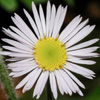 Erigeron pulchellus var. pulchellus, Robin's Fleabane (Robin's Plantain)
Erigeron pulchellus var. pulchellus, Robin's Fleabane (Robin's Plantain)
Flowers: Heads 1" or more wide, 1-7 per stem, ~50(-100) rays.
Leaves: Upper stem leaves small, with rounded bases, somewhat clasping.
Stems: Under 18" tall, densely hairy, spreading by runners.
Where: Moist woods, Piedmont only.
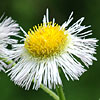

 Erigeron philadelphicus, Philadelphia Fleabane (Common Fleabane)
Erigeron philadelphicus, Philadelphia Fleabane (Common Fleabane)
Flowers: Heads under 1" wide, often more than 7 per stem, 100-150+ rays, often pink.
Leaves: Upper leaves have rounded bases, usually clasping the stem.
Stems: Up to 3' tall, usually hairy.
Where: Moist soils.
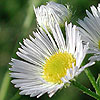
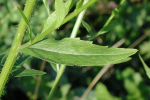 Erigeron annuus, White-top Fleabane
Erigeron annuus, White-top Fleabane
Flowers: Heads about 1/2" wide, 40-100+ rays.
Leaves: The numerous, toothed, upper leaves have a tapered base that does not clasp the stem.
Stems: Up to 5' tall, with long spreading hairs.
Where: Fields and roadsides.
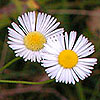
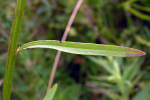 Erigeron strigosus var. strigosus, Daisy Fleabane
Erigeron strigosus var. strigosus, Daisy Fleabane
Flowers: 50-100 rays.
Leaves: The few, narrow, untoothed, upper leaves have a tapered base that does not clasp the stem.
Stems: Up to 3' tall, with hairs that lie close to the stem.
Where: Fields, roadsides, dry soils.
The accepted name for Erigeron canadensis, horseweed, is now Conyza canadensis.
Sources: The Flora of Delaware, Herbaceous Plants of Maryland.